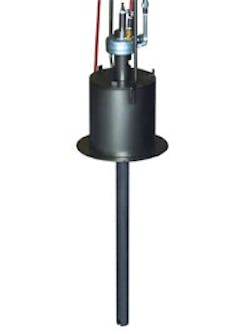Portable Rotary Degasser Lowers Aluminum Refining Cost
One of the products recently introduced by Palmer Manufacturing is a portable rotary degasser that offers efficient operation at low cost for aluminum foundries. By operating with dry nitrogen or argon, the degasser eliminates the need to use hazardous degassing tablets, or chlorine or Freon gases, to evacuate hydrogen gas from the molten aluminum. Also, nitrogen or argon is far cheaper to use than specialty gases.
Hydrogen degassing of aluminum is based on the principle that hydrogen gas will move from an area of high pressure in the melt to an area of low pressure in the inert gas. Hydrogen gas disperses throughout the molten metal, as it would if it were released in any confined space. It will maintain a constant pressure throughout the melt.
The ability of hydrogen gas to move through and equalize its pressure in liquid metal is almost as fast as it is in air. Therefore, it is unnecessary to bring every bit of metal in contact with the inert gas. How well and how fast a heat of aluminum can be degassed is determined by two factors: the transfer rate across the metal/gas interface and the surface area of the gas exposed to the metal.
Rotary degassing works on the principle of increasing the surface area of an inert gas introduced into the metal. The greater the surface area of the inert gas bubbles, the faster the degassing will occur. For a given volume of gas, the smaller the bubble size, the greater the total surface area of the gas, and the faster the degassing will be.
For example, a 1-in. diameter bubble of gas has a surface area of 6 in2. If the same bubble is divided into 0.0625-in. diameter bubbles, the surface area is increased to 96 in2. In other words, for the same volume of gas used, the surface area is increased by 16 times, increasing the effectiveness of the degassing by 16 times. Additionally, the small bubbles disturb the surface of the melt less, causing less hydrogen pickup on release.
Palmer recommends the use of dry nitrogen or argon with this degassing unit. Compatibility with specialty gasses cannot be guaranteed. With the exception of the graphite lance, every part of the unit that will be exposed to the gas is made of stainless steel or Buena-N (seals).
The Palmer Portable Rotary Degasser is powered by a -hp motor operating at variable speeds up to 3,600 rpm. The unit mounts either a 24- or 36-in. lance. The unit’s stainless steel body is 8 in. in diameter and 17 in. long. A mounting hook extends 14 in. above the body. Total weight is less than 50 lb.
The system is supplied with a combination air regulator-filter-lubricator for the air motor, and four standard lances. Prospective operators need only to provide a compressed air source at 90 to 120 psi, an overhead hoist, and a system with pressure regulator to provide nitrogen or argon gas.
The one-piece lance reduces cost by eliminating the shaft/impeller design used on some other degassing systems.
The degasser can be used for dip-out or crucible furnaces with capacities ranging from 40 to 3,000 lb. Degassing time estimates range from 1-5 min. for a crucible in the 70- to 500-lb range up to 5-10 min. for a 500- to 3,000-lb crucible.
The portable rotary degasser has a unique one piece lance, reducing cost due to the elimination of the shaft/impeller design. Portable and lightweight (under 50 lbs..), it also eliminates the use of hazardous degassing tablets and chlorine or Freon gasses.
“Anyone looking to improve their melt quality will appreciate the portability, heavy-duty stainless steel construction, and quality of this equipment,” says Jack Palmer, president of Palmer Manufacturing. “In addition to the rotary degasser, we now provide complete aluminum testing equipment with the reduced pressure tester, test bar mold, and spectrographic coupon mold.”
